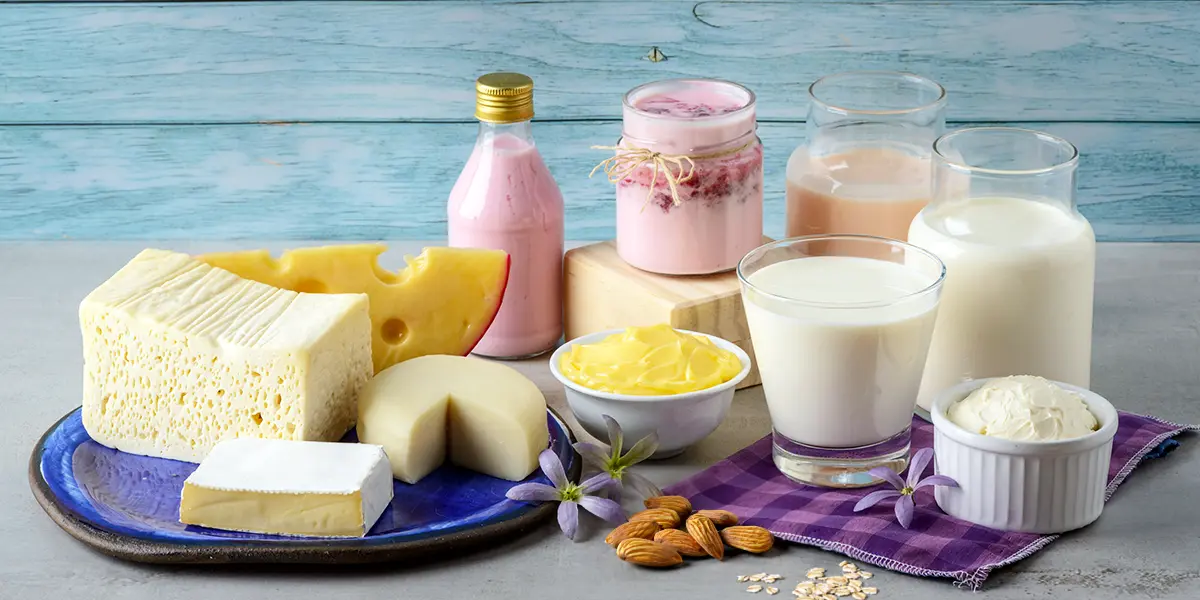17 Best Alternative Milk Products for Managing Diabetes

If you’re lactose intolerant or prefer alternative dairy options, these alternatives to traditional dairy are great choices.
Not only are they made for people who cannot tolerate lactose, but they can also help you control blood sugar better, thanks to their low Glycemic Index (GI) in unsweetened forms. These products are readily available in Indian markets and provide a healthier substitute for those looking to avoid animal-based dairy.
What are Milk Alternatives?
Milk alternatives are plant-based beverages made from various nuts, grains, seeds, or legumes, designed as substitutes for traditional dairy milk. They cater to those who are lactose intolerant, vegan, or simply looking to reduce animal-based products in their diet.
These alternatives come in various flavours and nutritional profiles, offering unique benefits like lower sugar content and specific nutrients.
Types Of Alternative Milks
1. Oat Milk
Oat milk is a moderate GI alternative with a GI of around 55-60. Made by blending oats with water, it has a naturally sweet taste.
Unsweetened versions are available for better blood sugar control. Oat milk is rich in fiber and provides a creamy texture, making it a great substitute for traditional milk.
2. Almond Milk (Unsweetened)
With a low GI (~30), unsweetened almond milk is perfect for managing blood sugar. It’s made by blending almonds with water, and it’s low in calories and contains heart-healthy fats and vitamin E. It’s a light, dairy-free milk alternative that works well in beverages and cereals.
3. Soy Milk (Unsweetened)
Soy milk has a low GI of 34. It contains an essential amino acid, making it a great choice for adding plant-based protein to your diet. Its low GI makes it ideal for blood sugar management.
4. Coconut Milk
Coconut milk is made by extracting the liquid from grated coconut. It’s thicker and creamier than most plant-based milks and is commonly used in cooking. At the same time, it provides fats, coconut milk is lower in protein, so it’s best combined with other protein sources.
To know your chances of Diabetes reversal, take the Diabetes Reversal TestDiabetes Reversal
Calculator
5. Rice Milk
Rice milk is a mild, sweet plant-based milk. It’s made by blending rice with water and straining it.
Rice milk is low in protein and higher in carbohydrates, giving it a higher GI than some other milks. Unsweetened rice milk is better for those managing blood sugar.
6. Cashew Milk
Cashew milk has a low GI (~30) and is made by blending cashews with water. It’s rich in healthy fats and has a creamy texture, making it ideal for smoothies or coffee. It’s lower in protein than soy milk but offers a good source of magnesium and other nutrients.
7. Hemp Milk
Hemp milk is made from hemp seeds and water. It’s rich in omega-3 fatty acids and plant-based protein. Hemp milk has a slightly nutty flavour and is often used in smoothies, cereals, and baking.
8. Pea Milk
Pea milk is made from yellow split peas and has a low GI (~30). It’s high in protein, providing a creamy texture similar to cow’s milk. Pea milk is a great source of calcium and vitamin D, making it an excellent dairy-free, high-protein milk.
Cheese Alternatives
1. Tofu
Tofu is made from soybeans and is an excellent plant-based cheese alternative with a very low GI (~0). It’s high in protein and contains all nine essential amino acids, making it perfect for a low-GI diet. Tofu is versatile and can be used in stir-fries, smoothies, or grilled for a different texture.
2. Cashew Cheese
Cashew cheese is made by blending soaked cashews with water and other ingredients, resulting in a creamy, low-GI cheese*. Rich in healthy fats and protein, it’s often used as a spread, dip, or in vegan sauces. Cashew cheese can also be used in cheese-based dishes like pizzas and pasta.
| Note: The glycemic index (GI) of cashew cheese is not specifically scientifically documented. However, we can infer its potential GI based on the GI of cashew nuts, which is reported to be 25, classifying them as low GI food. |
3. Almond Cheese
Almond cheese is a creamy cheese alternative made from ground almonds, and it has a low GI (~15). Softer and creamier than cashew cheese, it can be used as a spread, dip, or even in recipes that call for soft cheese. It’s rich in healthy fats and protein, making it a nutritious option.
4. Soy Cheese
Soy cheese is a dairy-free cheese made from soybeans. With a low GI of around 15, it’s a great alternative to traditional cheese. Soy cheese comes in various forms, such as slices, blocks, and shredded cheese, and is commonly used in sandwiches, pizzas, and pasta.
5. Coconut-based Cheese
Coconut cheese is made from coconut oil or milk and is a great option for those avoiding dairy. It’s firm in texture and has a mild coconut flavour. It has a low GI* and is often used in vegan cheese recipes, particularly as a topping or in cheese-based sauces.
| Note: While specific GI values for coconut cheese are not extensively documented, we can reference the GI of coconut itself, which ranges from 42 to 51 depending on the form and preparation of the coconut product. |
Butter Alternatives
1. Vegan Butter (Plant-Based Margarine)
Vegan butter is made from plant oils like coconut, olive, or avocado oil and has a low GI (~30). It’s used in cooking and baking as a replacement for traditional butter. Vegan butter provides healthy fats and is an excellent option for those following a dairy-free or vegan lifestyle.
2. Coconut Butter
Coconut butter is made from the flesh of the coconut and has a low GI (~30). It’s rich in healthy fats and can be used as a spread, in baking, or in cooking. Unlike coconut oil, which is pure oil, coconut butter contains the fiber of coconut meat, making it nutrient-dense.
3. Almond Butter
Almond butter, made from ground almonds, has a low GI (~30). It’s a healthy, low-GI butter alternative that’s rich in healthy fats, protein, and vitamin E. Almond butter can be used as a spread, in smoothies, or as a replacement for butter in various recipes.
Vegan Ice Cream
Made from plant-based milks like coconut, almond, or soy, vegan ice cream provides a creamy and dairy-free alternative to traditional ice cream. With a GI ranging from 30 to 60, it’s available in various flavours and offers a treat that’s both sweet and blood-sugar-friendly when opting for unsweetened versions.
Reduced diabetes medications in 3 months


6.8%
Happy members
EMI
Guarantee
4.8/5
Diabetes Prime Program
What are the Benefits of Adding Milk Alternatives?
- Better Blood Sugar Control: Many milk alternatives, especially unsweetened options, have a low GI, making them suitable for people managing blood sugar levels.
- Low in Calories: Most plant-based milks are lower in calories compared to whole milk, helping in weight management.
- Lactose-Free: Milk alternatives are ideal for lactose-intolerant individuals, as they do not contain lactose.
- Rich in Nutrients: Many plant-based milks are fortified with calcium, vitamin D, and other essential nutrients, providing a nutritious dairy-free option.
- Heart Health: Some alternatives, like almond and soy milk, are rich in heart-healthy fats, which can contribute to better cardiovascular health.
What are the Side Effects/Cons of Adding Milk Alternatives?
- Allergies: Some individuals may be allergic to nuts (like almonds or cashews) or soy. It’s important to check labels for allergen warnings.
- Added Sugars: Many commercially available milk alternatives, especially flavoured versions, can contain added sugars. Always opt for unsweetened versions to keep sugar intake in check.
- Lower Protein Content: While soy milk and pea milk are good sources of protein, other options like rice milk or almond milk contain much less protein than cow’s milk.
- Nutrient Fortification: Not all milk alternatives are naturally rich in calcium, vitamin D, or other nutrients. Look for fortified options to ensure you’re getting the nutrients you need.
- Taste and Texture: Some milk alternatives may have a different taste or texture than dairy milk, which may take some getting used to.
What to Consider When Substituting Dairy with Milk Alternatives
- Nutritional Needs: Ensure the milk alternative you choose meets your nutritional requirements, especially for calcium and protein.
- Taste Preferences: Different milk alternatives have varying tastes and textures. Choose one that fits your flavour preferences for daily consumption.
- Dietary Restrictions: Consider any food allergies, such as soy or nuts, when selecting a milk alternative.
- Fortification: Some plant-based milks are fortified with essential vitamins and minerals. Check the labels for added nutrients like calcium and vitamin D.
- Usage: Some milk alternatives work better in cooking, while others are better for drinking or adding to coffee and smoothies.
How We At Fitterfly Can Help You?
Milk alternatives like almond, soy, and pea milk are not just great dairy substitutes; they’re also powerful allies in managing diabetes due to their low Glycemic Index and nutrient-rich profiles. At Fitterfly, we go beyond just recommending these options – we help you incorporate them into a personalized, diabetes-friendly lifestyle that works for you.
Our expert Nutrition Coaches design meal plans that include milk alternatives tailored to your unique health needs, ensuring they not only help control blood sugar but also provide essential nutrients like calcium and protein.
Paired with guidance from our Fitness Coaches, who craft activity routines to complement your diet, and our Success Coaches, who help you build lasting habits, we ensure a 360-degree approach to managing diabetes effectively.
At Fitterfly, we don’t just provide advice – we empower you with actionable solutions that fit seamlessly into your daily life. Ready to see the difference? Call us at 08068507599 and take the first step toward better health today!
This blog provides general information for educational and informational purposes only and shouldn't be seen as professional advice.
Frequently Asked Questions
What is used to make non-dairy milk?
Non-dairy milk is made from plant-based ingredients like nuts (almonds, cashews), grains (oats, rice), seeds (hemp, chia), and legumes (soy, peas), which are blended with water and processed into a smooth, milk-like consistency.
Which alternative milk has the least sugar?
Unsweetened almond milk and unsweetened soy milk have the least amount of sugar, making them excellent choices for those looking to reduce their sugar intake.
What is the best alternative to milk?
The best alternative to milk depends on individual needs. For protein, soy and pea milk are excellent; for low sugar and a mild taste, almond or oat milk works well.
What to drink instead of milk?
Plant-based milk like almond, soy, or oat milk are great alternatives to dairy milk. They offer various nutritional benefits and are lactose-free.
How do you get calcium without dairy?
Calcium can be obtained from plant-based milk (like fortified soy or almond milk), leafy greens, tofu, nuts, seeds, and certain fortified cereals and juices.
Which milk alternative is healthiest?
Due to their high protein content, Soy and pea milk are often considered the healthiest alternatives. However, the healthiest option depends on individual dietary needs.
Which milk alternative is high in protein?
Soy milk and pea milk have the highest levels of protein among plant-based milks. Both provide a good amount of protein per serving.
Can we drink coconut milk daily?
Yes, coconut milk can be consumed daily in moderation. It’s rich in fats but low in protein, so it’s best paired with other protein sources.
Which is better for people with diabetes, oat milk or almond milk?
Unsweetened almond milk is a better choice for people with diabetes due to its lower GI (~30), which has a lesser impact on blood sugar levels. Oat milk has a moderate GI (~55-60) and may cause a slight increase in blood sugar.




















